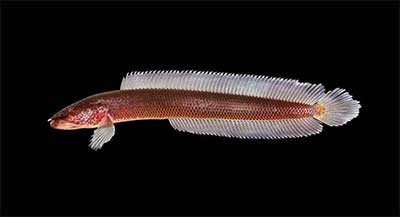Daily-current-affairs
/
27 Oct 2020
New Family of Bony Fish Discovered : Daily Current Affairs

New Family of Bony Fish Discovered
Why in NEWS ?
- New family of bony fish discovered in Western Ghats.
ABOUT
- Scientists from India, Germany, United Kingdom and Switzerland have discovered a new family
of bony fish from the Western Ghats, and named it Aenigmachannidae.
- Results of this study was published in Scientific Reports, the open-access mega-journal of the
Nature Publishing Group.
- A year after the discovery of the enigmatic Gollum Snakehead, Aenigmachanna gollum from the
rice fields of northern Kerala, scientists have now conducted detailed studies on its skeleton and
genetic assembly.
- The study led to the recognition that this species, and its congener Aenigmachanna mahabali,
represents a new family different from Channidae, in which both species were initially placed.
WESTERN GHATS
- The Western Ghats, also known as Sahyadri (Benevolent Mountains), is a mountain range that
covers an area of 140,000 square kilometers in a stretch of 1,600 kilometres parallel to the
western coast of the Indian peninsula, traversing the states of Tamil Nadu, Kerala, Karnataka,
Goa, Maharashtra and Gujarat.
- It is a UNESCO World Heritage Site and is one of the eight hot-spots of biological diversity in the
world. It is sometimes called the Great Escarpment of India. According to UNESCO, the Western
Ghats are older than the Himalayas.
- Total of thirty-nine areas in the Western Ghats, including national parks, wildlife sanctuaries and
reserve forests, were designated as world heritage sites in 2012 – twenty in Kerala, ten in
Karnataka, six in Tamil Nadu and four in Maharashtra.
- The Western Ghats contain more than 30 per cent of all plant, fish, herpeto-fauna, bird, and
mammal species found in India. Many species are endemic, such as the Nilgiri tahr (Hemitragus
hylocrius) and the lion-tailed macaque (Macaca silenus). In fact, 50 per cent of India’s
amphibians and 67 per cent of fish species are endemic to this region.
- The region has a spectacular assemblage of large mammals - around 30 per cent of the world’s
Asian elephant (Elephas maximus) population and 17 per cent of the world’s existing tigers
(Panthera tigris) call this area their home.
CONCLUSION
- The presence of two unique endemic families of freshwater fish in a small region like Kerala is
unparalleled, and indicates the exceptional diversity and endemicity of fishes in this part of the
world.
- The aquifers of Kerala have a wealth of enigmatic and relic fauna, the diversity of which we are
only slowly uncovering.
- But subterranean ecosystems are under high levels of threat due to indiscriminate ground water
extraction and pollution, and introduction of alien species in the dugout wells. As a result, we
may be losing unique habitats and species much before they are known to science.







